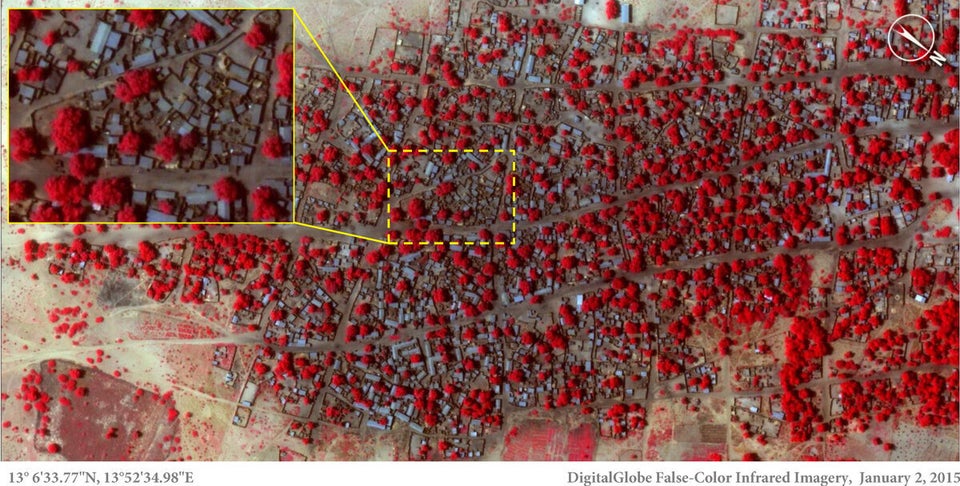The sheer scale of a Nigerian terror group's most horrific and deadly attack yet has been laid bare in stark satellite images of homes, hospitals, schools and shops burnt and smashed to ruins.
One of the victims was a pregnant woman shot while in labour during the rampage, witnesses told Amnesty International. “Half of the baby boy is out and she died like this,” a witness said, saying the militants were shooting indiscriminately killing even small children.
The images, released by Amnesty International today, show the vastness of the destruction wreaked upon the towns of Baga and Doron Baga by Boko Haram.
The before-and-after pictures show the two neighbouring towns, 2.5km apart, taken on the 2nd and then on the 7th of January, after the attack which obliterated or near destroyed 3,700 buildings and structures. Many of the wooden fishing boats along the shoreline in the fishing town of Doron Baga, visible in the images taken on the 2 January, are no longer present in the 7 January images tallying with eye witnesses’ testimony that desperate residents fled by boat across Lake Chad.
“They killed so many people," a man in his fifties, witness to the chaos, told Amnesty. "I saw maybe around 100 killed at that time in Baga. I ran to the bush. As we were running, they were shooting and killing.” He hid in the bush and was later discovered by Boko Haram fighters, who detained him in Doron Baga for four days.
“These detailed images show devastation of catastrophic proportions in two towns, one of which was almost wiped off the map in the space of four days," Daniel Eyre, Nigeria researcher for Amnesty International, said.
“Of all Boko Haram assaults analysed by Amnesty International, this is the largest and most destructive yet. It represents a deliberate attack on civilians whose homes, clinics and schools are now burnt out ruins. Up until now, the isolation of the Baga combined with the fact that Boko Haram remains in control of the area has meant that it has been very difficult to verify what happened there.
“Residents have not been able to return to bury the dead, let alone count their number. But through these satellite images combined with graphic testimonies a picture of what is likely to be Boko Haram’s deadliest attack ever is becoming clearer."
The charity has questioned the claims of Nigeria’s Director of Defence Information who stated that the number of people killed in Baga including Boko Haram fighters "has so far not exceeded about 150". "These images, together with the stories of those who survived the attack, suggest that the final death toll could be much higher than this figure," Eyre said.
“I don’t know how many but there were bodies everywhere we looked,” one woman told Amnesty.
The Boko Haram fighters were believed to be targeting communities for collaboration with security forces, and those where civilian militias, known as JTFs, have formed. A witness told Amnesty that during the attack on Baga he heard Boko Haram fighters saying they were searching for Civilian JTF members, as they went house to house shooting men of fighting age.
Several told Amnesty that Boko Haram drove into the bush rounding up women, children and the elderly who had escaped. According to one woman who was detained for four days: “Boko Haram took around 300 women and kept us in a school in Baga. They released the older women, mothers and most of the children after four days but are still keeping the younger women.”
Médecins sans Frontières reported on Wednesday that 5,000 survivors of the attack on Baga are staying in a camp in Maiduguri, while the UN's refugee agency UNHRC reported on January 9th that some 7,300 Nigerian refugees had arrived in western Chad.
